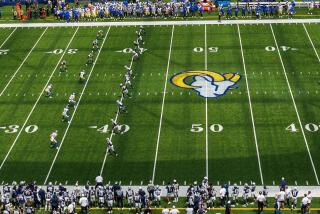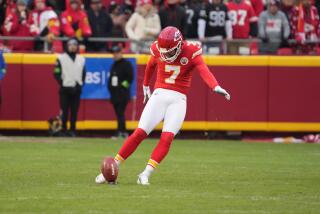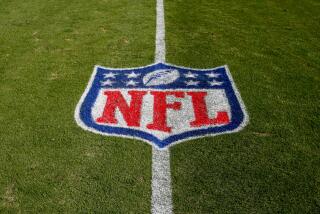League’s Best Defense Will Be Good Offense
Every few years, when enough players have complained that hooking, holding and grabbing are smothering their creativity, NHL executives decide to purge obstruction.
But as soon as players begin parading to the penalty box, coaches whine, referees back off, and what was a penalty in October isn’t a penalty in April. By the start of the playoffs, obstruction is worse than ever, forcing skill players to fight through the defensive tactics that have dramatically reduced scoring over the last decade.
The NHL has targeted obstruction again this season, and NHL Commissioner Gary Bettman insists this crusade won’t fall short. There’s a reason for his confidence.
During similar efforts in 1995 and 1998, referees worked alone. This time, two referees will be on the ice to police each game. NHL supervisors will evaluate referees’ enforcement of the obstruction rule, especially regarding the use of the free hand and the stick to check when the opposing team has the puck. In addition, general managers, coaches and on-ice officials will confer every 20 games to help maintain consistency.
Perhaps most important, the NHL has the backing of the executives, coaches and referees it consulted before it introduced its latest endeavor to clean up the game and capitalize on the world-class skills of its players.
“The part about laziness, the part about locking on and just grabbing ahold of a guy, is just out,” said Philadelphia Coach Ken Hitchcock, adding that he’s excited by the prospect of forechecking becoming an offensive tool instead of merely a defensive tactic.
“It’s going to be called much stricter, and that way, it’s going to reward people who are hard-working offensive and hard-working defensive teams.... The game will be played on the ice with more than just the one-on-one or two-on-two taking place. The people away from the puck, the working people away from the puck, are going to be rewarded now.”
The NHL faces many difficult issues as it prepares to open its 86th season Wednesday. Its Canadian teams still face inequities caused by the currency disadvantage. The league is operating the Buffalo Sabres until a buyer can be found for the franchise, which was orphaned by the financial fall of the Rigas family. Dallas Stars’ owner Tom Hicks is exploring selling his club, and the Mighty Ducks, lauded a decade ago for bringing Disney into the ownership ranks, are also on the block.
ESPN will televise fewer games this season, an offshoot of ABC/ESPN having bought the rights to NBA games. And with the resolution of baseball’s labor problems, the NHL stands next in line for a work stoppage when its collective bargaining agreement with the players’ union expires on Sept. 15, 2004.
But of all its concerns, none go to the heart of the game itself as do the edicts to banish obstruction and adopt the “hurry-up” line changes that sustained momentum and streamlined games during the Salt Lake City Olympic hockey tournament.
Few other changes seem as important to the future of the NHL. Its national TV ratings remain low, and although its teams played to more than 91% of capacity last season, hockey isn’t as widely or deeply entrenched as baseball, basketball or football. Giving offense-oriented strategies better odds against the defenses that have blighted the game might be the NHL’s best marketing strategy.
“Something had to happen,” said Duck forward Paul Kariya, who figures to benefit from the crackdown. “Scoring’s down every year, and that’s what attracts fans. You want to have exciting, offensive hockey, and it’s tough to do that when you have 200-pound guys on your back.”
The elimination of obstruction will challenge coaches who, whether by choice or lack of scoring power, have resorted to defensive schemes to slow superior teams. It will also challenge gifted players to reinvigorate the game.
“I really believe the smart players defensively have already gotten onto it,” San Jose Coach Darryl Sutter said. “If you’re smart and you can skate, it’s not a problem. I think it’ll be really good.”
The changes ask a lot from a lot of people. But nothing impossible.
“I think these rules are good for our team,” King Coach Andy Murray said. “I don’t think there’s a lot wrong with the NHL game now, and if this makes it better, we’re in for a real treat.”
Said Duck General Manager Bryan Murray, “I believe if you demand it of someone, the players will adapt. And by the time the season starts, we’ll be in better shape than we have been for a while. None of us like 10 penalties a game, and that’s where coaches come into play. They have to warn players that if a guy takes a lot of penalties, he’s got to do something about it.
“I think they have a great chance of succeeding with this. Everyone wants it to happen to make the game better, and I’m sure it will.”
King General Manager Dave Taylor said defending players must be more aware of body position and must avoid one-handed reaches with their sticks, but that other possibilities will open.
“You might see the goalkeepers be a little more active,” he said.
Kevin Lowe, general manager of the Edmonton Oilers, anticipates less body contact in the neutral zone but no drop in hitting in the end zones.
“I don’t think we’ll see a return to teams scoring 400 goals, although it would be nice,” he said. “I think there’s still excellent coaching in this league, and there’s still players that are much more aware defensively than they were a decade ago or two decades ago.
“But this will allow for a little more freedom of movement, which will enhance the product.”
All of which sounds great--as long as the rule is enforced evenly and consistently.
“I hope they call it. That would be great for the game,” said speedy forward Tony Amonte of the Phoenix Coyotes. “You’ll see a lot more three-on-twos and you’ll see people really skate.
“If they’re going to stick with it, great. Don’t do it in camp and then lay off. And in the playoffs, it seems like everything goes out the window.”
Kariya is also skeptical.
“I’ll believe it when I see it,” he said. “Even in the first two exhibition games [at the Pond], I don’t think they were strict enough about it. I can just see that over the season, it’s going to get worse and worse.”
Kariya said knowing that former referee Andy van Hellemond, now the NHL’s director of officiating, was involved in the planning gave him reason to hope this might take root.
“Still, there are tendencies [to relax],” Kariya said.
Not if Bettman has his way.
“We believe that the way the standard has been articulated and how it’s being implemented, we can hold it,” he said.
“I think what we have is a process that everybody is buying into.”
Hitchcock singled out the Oilers, Colorado Avalanche, Kings and Detroit Red Wings as teams most likely to benefit because they cycle the puck well and throw players into the offense. Sutter included his San Jose team in the mix.
“I think there’s a lot of really good skating teams that will be helped, and most of the teams in the Western Conference,” he said. “Look at our [Pacific] division: all the clubs can really skate.”
The hurry-up line changes, popular at the Olympics, forbid players to dally before faceoffs. Visiting teams will have five seconds to make a line change after a stoppage and the home team will have eight seconds. A team that tries to make a change after the referee gives the stop sign will get a warning on the first offense and a bench minor for subsequent offenses.
The linesman conducting the faceoff will blow his whistle after the referee has lowered his hand for the line changes, to indicate all players must be in position and onside for the faceoff within five seconds. Players who delay getting to the faceoff spot or line up in an offside position will get warnings, then will be penalized for any repeat violations. The last two provisions won’t apply in the last two minutes of regulation time or in overtime.
“It will dress up the game more and make players much more conscious of line changes and getting the game going and not standing there arguing with the linesman,” Bryan Murray said. “They’d go out and take the tape off their stick, talk to the linesman and then skate back out to the circle. Sometimes it would take a good half-minute or more to get it going. Now, we’ll have a chance to get momentum and have a chance to play more players.”
Said Andy Murray, “I wouldn’t have wanted to have that rule right after I came back from my concussion [the result of car accident last season] because you have to be aware all the time.”
Bettman is aware that a lot is riding on these changes.
“We want the best hockey being played every night, and if that means some teams win a little more and some teams losing a little more, so be it,” he said. “And that’s why I think it will improve the flow, open up the game in ways that we’ve talked about, but I don’t think it will dramatically alter the standings. And if it does, so be it.”
More to Read
Go beyond the scoreboard
Get the latest on L.A.'s teams in the daily Sports Report newsletter.
You may occasionally receive promotional content from the Los Angeles Times.







